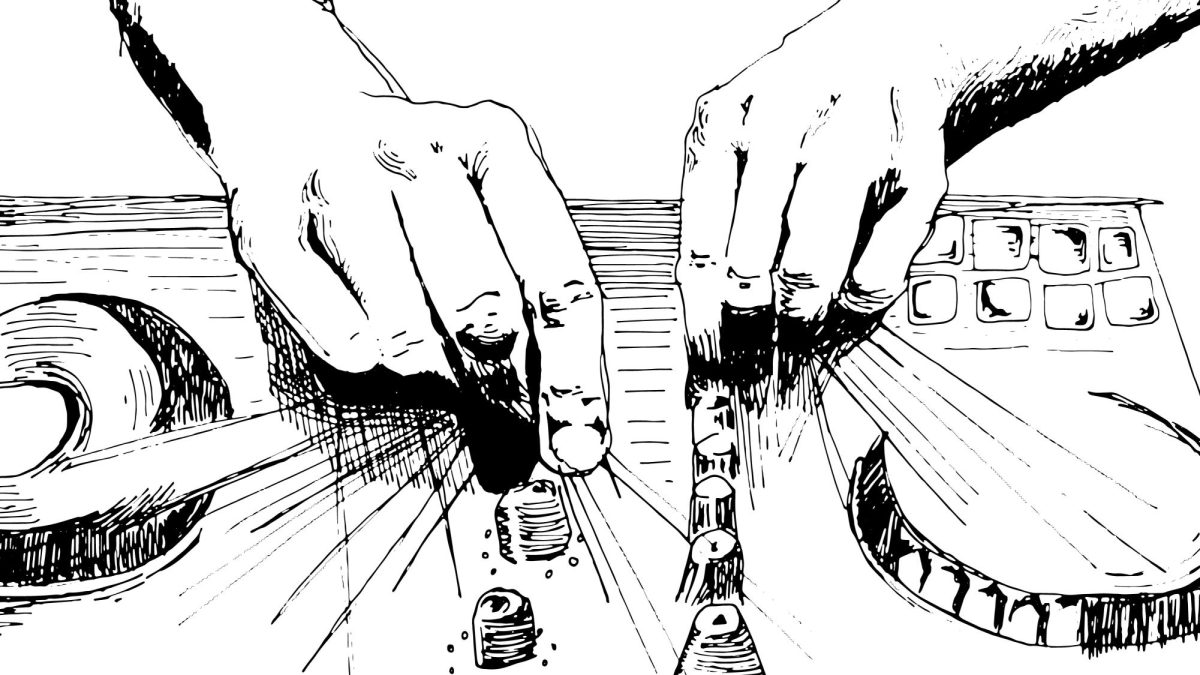
The Ballad of Songbirds and Snakes, originally a novel written by Suzanne Collins, is the newest edition to the Hunger Games cinematic universe. Taking place 64 years before the original trilogy, the Hunger Games prequel follows a young Coriolanus Snow (Tom Blyth) — the future dictator of the fictional nation Panem — as he mentors District 12 tribute Lucy Gray Baird (Rachel Zegler). The film focuses on the tension between their growing connection and Snow’s Icarian ambition.
Many fans of the Hunger Games series were drawn to theaters by the active social media fandom. Whether referencing fan-made videos of Tom Blyth, commonly known as thirst traps, or the inescapable Josh Hutcherson “Whistle” edit, students expressed that social media inspired them to watch the film. “I probably wouldn’t have seen the movie if it wasn’t such a big thing on social media,” Shaza Mousa ’27 said.
“A good edit or good fan art will convince me to watch something more than any actual promotional material,” Jackie Zhang ’27 added. “I also see a lot of actors like Rachel Zegler retweeting the [fan] edits and encouraging fan creations.”
They commented on how online promotion has been drawing in more movie fans as large production studios like Lionsgate hire young TikTok celebrities to make promotional videos. “The Lionsgate TikTok account is making edits,” they said. “I feel like when the Hunger Games first came out, they were still unused to fandom culture. But this time they’re really taking advantage of it and using it to promote their movie.”
Leah Williams ’25 said that the rise of social media has not just benefited film promotion but also encouraged deeper dives into movies. “There are thirst traps, but there are also videos analyzing scenes and anti-capitalist messaging in the movie,” Williams said. “I think it’s important to analyze the media that we’re taking in while also being critical of the analysis videos we’re watching — keeping in mind what point of view that that creator is coming from.”
Students appreciated the use of music in The Ballad of Songbirds and Snakes. The tribute Snow mentors and his love interest Baird is a member of a musical troupe and showcases her singing several times throughout the film in a style that music producer Dave Cobb called “dystopian Appalachia,” according to Variety Magazine.
“I liked the Appalachian and Romani influence on her singing — her heritage and culture,” Zhang said. “I thought that was very interesting — the worldbuilding of the music.”
Students also expressed excitement about the movie’s aesthetic, specifically within the Capitol — a dystopian city home to Panem’s wealthiest citizens — and how it expanded the world of the original Hunger Games movies. “This movie’s aesthetic felt really different,” Josh Kirschner ’24 said. “In the original [films], the Capitol is so colorful — with all their weird makeup, hairstyles, outfits, and crazy mustaches — because it’s showing the overconsumption of the Capitol. This one was so muted aesthetically. It reminds me of the late 1940s or 1950s, the post-World-War-II, utilitarian look, because this is 10 years after Panem’s massive war. I really liked this simple, rigid, and sharp aesthetic.”
In addition to the new Capitol aesthetic and expanded worldbuilding, students noted that The Ballad of Songbirds and Snakes addressed different themes and made different social commentaries than the original films. “I feel like this movie specifically serves a different purpose than the previous movies,” Zhang said. “[In the original films,] there’s a lot of commentary on revolution and liberation, oppressive forces and how people resist, but this movie feels like more of a meditation on power and how working within the system can corrupt.”
Another difference students noticed between the original movies and the prequel was the young tributes’ levels of comfort in and preparation for the Games. “Everyone was so much more innocent to the idea of the Games [in The Ballad of Songbirds and Snakes] since it’s so new,” Williams said, reflecting on how the film centers around the 10th Hunger Games while the original films focused on the 74th and 75th Games. “Children aren’t used to the reality and possibility of going out and killing one another, unlike in Katniss’s time, where there are training centers set up for the tributes to practice murder.”
Students expressed that the violence in The Ballad of Songbirds and Snakes was more gratuitous than the original Hunger Games. “I think this [prequel] was especially violent, and I don’t even think it serves a purpose,” Kirschner said. “There were 24 [tributes] in an open circle with nowhere to hide — they were going to kill each other in 10 minutes … I think you can make a commentary about our consumption of the violence. What I take away from the movie is how survivalism and the corruption of humanity can make people be so violent. But I don’t need to see some 13-year-old have his head smashed in to know that.”
However, when describing the violence on screen in a Dexerto article, director Francis Lawrence expressed a different sentiment. “The truth is you want these scenes to have some intensity, but you also have to make sure they’re not so intense that you get an R-rating and you alienate the teenage audience… So I always sort of focus on the emotional impact of violence, as opposed to blood and gore or whatever,” he said.
Students also expressed frustration with what they described as the rushing of Snow’s descent into villainy. “We live in a world where media literacy is kind of lacking — it’s just becoming harder and harder to show, not tell,” Mousa said. “But I feel like they definitely could have done a better job at showing his progression.”
“Maybe it would have helped if I had read the books and understood his thought process,” Zhang added.
Despite students’ criticisms of the film, many said that its commentary on exploitative media consumption and hyper-voyeurism was especially powerful in the age of social media and reality TV. “Reality TV shows about romance or drama, or true crime podcasts are us getting entertainment out of very brutal and serious elements of people’s lives,” Kirschner said. He noted that reality TV shows frequently construct a villain narrative — giving the audience characters to root for and against in a similar way to how the Hunger Games films do.
“Reality TV is about the reality that we construct together, and I think that the movie takes it to that extreme,” he said.
Kirschner additionally commented on how the movie inspires exploitative consumerist desires for violence in its audience. “I want to see Haymitch [Abernathy’s] Games, but I keep thinking, ‘Does that make me a bad person?’” he said. “Because that is the point of the movie: We live in this overconsumption society where we get pleasure from the sensationalization of other people’s lives.”
Mousa expressed a similar sentiment, adding that fans wanting more Hunger Games movies based around different Games is problematic. “I hate that so much,” they said, referencing fans’ desires to see the Games of Abernathy — Katniss’s mentor from the original Hunger Games trilogy. “We do not want to be able to watch every single Hunger Games on screen, because that’s the issue in that world! The point is not, ‘Oh, let’s watch these children kill each other and be entertained by it,’ because then, we’re part of the problem.”







